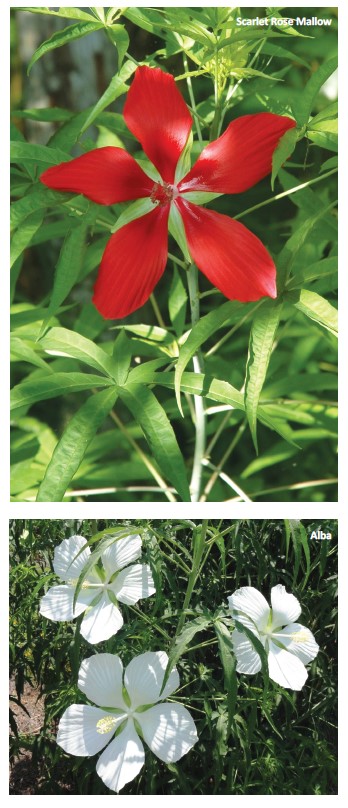Galveston gardeners share a distinct fondness for hibiscus, as evidenced by the proliferation of these plants in landscapes and gardens all over the isle. However, there are three varieties that are sighted less often than others—the cousins. With over three hundred species, Hibisceae is the largest clan of the family Malvaceae, a group of flowering plants with over four thousand species including okra, cotton, and cacao. Popular hibiscus such as Rosa Sinensis, the Bahama Bay Collection, Hollyhocks, Confederate Rose and Turk’s Cap are cousins to the lesser-known Althea, Swamp Rose Mallow, and the Texas Star.
 Althea (hibiscus syriacus)
Althea (hibiscus syriacus)
Commonly called Rose of Sharon or Chinese hibiscus, this species was quite popular in grandmother’s time but seems to have lost ground to the more contemporary and flamboyant selections now featured at garden centers. Native to China, India, and Japan, it produces large eye-catching blooms from summer to fall. This is a hardy, low maintenance shrub or specimen plant that is tolerant of various soil types, hot weather, and wind.
This national flower of Puerto Rico and Korea is an ornamental upright shrub or tree with a vase-shape growth habit that can reach to ten feet with a six-foot spread. The blooms are typically 3-6 six inches in diameter in shades of white or red to violet or blue with red centers that boast a prominent white stamen.
Attractive to hummingbirds and butterflies, the althea favors hot summers and full sun but will tolerate partial shade. Called “urban-tolerant” because of its ability to withstand heat, humidity, drought, and poor soils, this species is hardy and vigorous.
Plant in spring or fall in well-draining soil, add compost and mulch in spring, then prune before new growth begins. The Rose of Sharon is easily transplanted or rooted by stem cuttings with few pests or diseases. Any aphids, spider mites, or whiteflies can be readily controlled with commercial or organic sprays.
Althea Cultivars Aphrodite- pink-mauve single bloom, dark magenta eye
Ardens- mauve-purple double bloom, dark magenta eye
Blue Bird- lavender single bloom, dark magenta eye
Diana- white single bloom
Minerva- lavender to mauve single bloom, red eye
Red Heart- white single bloom, scarlet eye
Swamp Rose Mallow (hibiscus moscheutos) This breed is a “hardy’’ hibiscus as opposed to the tropical type that we see every day, and it is commonly called the giant rose mallow as the blooms are truly “dinner-plate” size. The flowers range from 6-12 inches across and appear primarily in shades of red, rose, pink, or white. These unusual and showy blooms continue their extravagant display from May through October.
The leaves are dull rather than shiny with some cultivars boasting bronze or purple foliage. With its forceful growth habit, the swamp mallow may develop to five or six feet in height. After the blooming cycle, the plants stop their growth and enter a dormant stage, the upper growth dies back to the ground with crowns and roots remaining living over winter. The new growth appears in March or April.

The hardy hibiscus is native to the southeastern United States and well-adapted to the Galveston climate, thriving in the heat and humidity of summer months. They are long-lasting and robust in zones 5-10, and they prefer full sun for maximum performance but will grow and bloom in partial shade.
Plant in a moisture retaining soil, add compost or other organic material. Water regularly and often to establish a healthy and dynamic root system (do not allow a mallow to dry out as they will stop blooming immediately).
Mulch heavily to help maintain moisture and fertilize with a balanced formula to encourage peak development. Cut back to the ground in winter. Mallows can be easily propagated by dividing the root mass, from seed, or by tip cuttings (clip the cuttings in early July, keep moist).
Medicinal and culinary folklore abounds concerning hibiscus in general, and according to natural medicine enthusiasts, the swamp mallow may be used in the treatment of dysentery and lung and urinary ailments. The flowers are edible with a mild but bitter after taste; the leaves are also edible, but their hairiness may be off-putting.
Mostly disease resistant, swamp mallow can become a target of aphids, scale, whiteflies, and mites especially on ones with the largest blooms. Insecticidal soap, neem oil, or insecticides can quickly address the problem.
Swamp Rose Mallow Cultivars
Lord Baltimore- bright red bloom, ruffled foliage
Kopper King- white bloom, copper-red with orange underside, maple leaf-shaped foliage
Peppermint Schnapps- pink bloom with red streaks, red eye
Blue River II- oversized pure white bloom
Southern Belle- red, pink, white or bi-colored bloom
Texas Star (hibiscus coccineus)
This Texas native matures to heights of 3-6 feet with a 4-foot spread. The blooms of the Texas Star are large with five very distinctive petals while the leaves have a similar shape to that of cannabis. It will die back in winter leaving lifeless looking stems visible, but do not cut these stems out until warmer weather in the spring. Mulch well around the plant to protect from a hard freeze. New growth will emerge after the spring pruning.
Plant in full sun or partial shade in any well-draining soil. This plant acclimates very well to most soils and needs little maintenance other than a balanced fertilizer applied monthly during the summer. Pests and disease are rare.
Hummingbirds and butterflies are especially attracted to it. Texas Star presents well in containers, although more frequent watering may be required. The Star will thrive for many years delivering reliable blooms and lush green foliage.
Texas Star Cultivars
Alba- white bloom, yellow eye
Red Flier- deep pink bloom
Scarlet Rose Mallow- bright red bloom